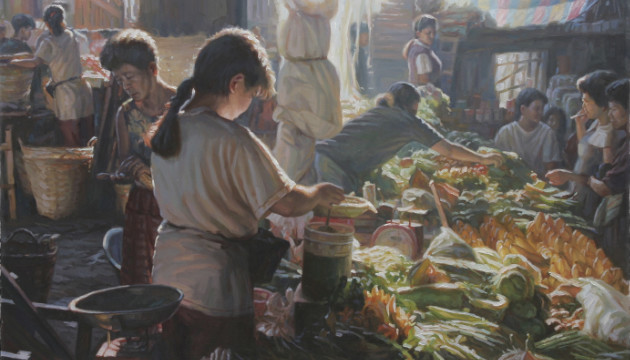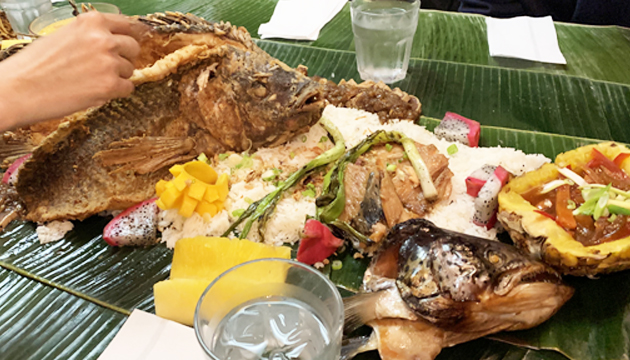January 1, 2025 — In 1989, Edgardo Lantin, a gifted portrait artist from Vancouver, presented former Philippine President Corazon Aquino with a portrait of herself on behalf of the Canadian Filipino community.
This gesture marked the beginning of a remarkable career in which Lantin would become renowned for his lifelike portraits of world leaders, philanthropists, and other prominent figures. His work graced notable venues, including VanDusen Gardens and the BC Cancer Research Library in Vancouver, leaving a lasting impact.

Lantin’s talent for capturing the essence of his subjects became widely recognized after he painted portraits of influential figures, including former Philippine President Noynoy Aquino, whose likeness now adorns the halls of Malacañang Palace. His skill in portraiture is evident in his portraits of notable figures such as philanthropist Whitford VanDusen, Dr. Donald B. Rix, and former Prime Minister Stephen Harper. His works not only capture likeness but also convey the character and stories of each individual, making his portraits treasured artifacts of history.
Lantin’s artistic journey began with a Bachelor of Science in Fine Arts from the University of Santo Tomas in the Philippines, where he majored in Advertising. After relocating to Vancouver in 1981, Lantin worked as a graphic artist while pursuing his passion for painting. He met his mentor, Sofronio Ylanan Mendoza (SYM), and studied under his guidance. His quest for mastery led him to a one-year scholarship at the esteemed Art Students League of New York, where he refined his drawing, anatomy, and painting skills under the mentorship of renowned artists such as Michael Burban and Harvey Dinnerstein. He also studied sculptural anatomy at The New York Academy of Art with Eliot Goldfinger.
Lantin draws inspiration from the Old Masters—Diego Velázquez, John Singer Sargent, and Rembrandt—whose portraits he admires for their ability to make subjects seem as though they are emerging from the canvas. He believes that the key to a powerful portrait lies not only in capturing likeness but in imbuing the subject with life and soul. Lantin strives to create a connection with his subjects, transcending the surface to express the essence of who they are. This philosophy makes his works compelling: they capture more than just a moment in time; they tell a narrative that resonates with viewers.
While Lantin’s portraits are renowned for their lifelike quality, his landscapes are equally significant, providing a deeper glimpse into his personal history and connection to Filipino culture. Many of his works evoke nostalgia, capturing scenes from his early years in Lipa, Batangas. One such painting, inspired by the sights and sounds of his hometown, reflects his memories of the vibrant town plaza and the busy jeepneys transporting fresh fish to the local marketplace.
He discovered that these jeepneys transported fresh fish from the nearby city of Lucena to the market in Lipa. In 1997, a client suggested he create a painting and visit the provinces for inspiration. Lantin contemplated Dalahican in Lucena City, where he saw large boats unloading fish caught from nearby islands. He observed fishermen hauling their catch as they carried heavy loads up an incline. The image of gladiators in Juan Luna’s acclaimed painting Spoliarium flashed through Lantin’s mind. He envisioned a scene depicting the hardworking fishermen in their daily grind. The piece, titled Hauling Fish, a 4’x8’ oil painting, was his tribute to Luna’s Spoliarium.
Lantin’s landscapes often convey his desire to capture fleeting moments and elements of Filipino life that may soon fade away.
In recent years, Lantin has focused on the Tboli people of South Cotabato, a project deeply connected to his roots. After visiting Lake Sebu in 2011, he began a series of paintings that illustrate the Tboli’s unique way of life, their bond with nature, and the enduring traditions of their culture. Lantin views this project as a tribute to his mother’s heritage and a vital cultural preservation endeavor. Through his brush, he captures the timeless beauty of the Tboli people, ensuring their stories and traditions endure for generations to come.
The multi-award-winning artist has been a Signature Member of the Federation of Canadian Artists for decades. In 2004, his painting Vegetable Vendor, depicting a Philippine market scene, won the Grand Prize among 777 entries in the 2004 Painting on the Edge international competition.
 Edgardo Lantin’s 2004 painting “Vegetable Vendor” depicts a Philippine market scene.
Edgardo Lantin’s 2004 painting “Vegetable Vendor” depicts a Philippine market scene.
This gentle, unassuming artist captures his observations using paint palettes and brushes, blending them with his vision, knowledge, and experience. He seeks the northern light to enhance the illumination of forms through its light and shadows.
Lantin is a respected Signature member of the Dimasalang III International Artist Group, a non-profit organization. During the summer, the group meets weekly to paint en plein air in parks throughout Metro Vancouver. They also gather indoors for life drawing and still-life sessions. He dedicates his time to giving lectures and sharing his knowledge and experience in art. “It gives me pleasure to contribute in any way,” he noted, recalling what his mentor SYM once said: “I’ll give you the key and open the door for you. It’s up to you to experiment, nurture it, and hone your skill.” Both have inspired a new generation of artists.
Dimasalang's president, Leo Cunanan Jr., states: “Ed Lantin has been a prominent figure in the Filipino art scene since the 1980s. He consistently showcases his work in community art exhibits and shares his creative expertise with various Filipino media platforms. His contributions have significantly promoted Filipino culture and artistry, making him a respected and influential artist within the community. He has devoted much of his life to creating exquisite artworks that stand alongside the masterpieces of the great artists who came before him.”
Edgardo Lantin’s legacy extends far beyond his artistry. His portraits—each a soulful depiction of a person’s essence—and his landscapes—rich with personal history and cultural significance—will serve as enduring monuments to his vision. From the dignitaries whose likenesses grace prestigious institutions to the evocative scenes of Filipino life that preserve the narratives of his homeland, Lantin’s art will be cherished for generations. His works are more than just stunning paintings; they are cultural treasures that resonate with the heart of the Filipino experience, ensuring his legacy as a master of portraiture and a guardian of cultural history.












